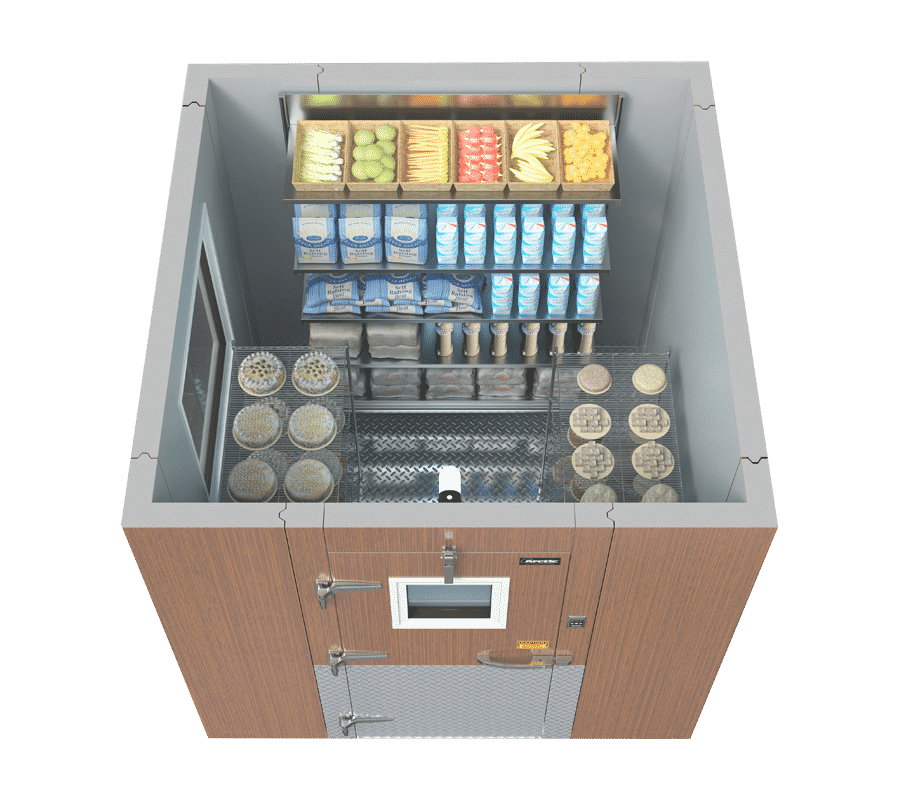Whether you’re setting up a new walk-in freezer or optimizing an existing one, organized storage helps preserve product quality, improve staff efficiency, and maintain your freezer’s performance. Follow these tips for a streamlined walk-in freezer that meets health and safety standards.
1. Choose Effective Shelving and Storage Containers
Proper shelving and storage containers are the foundation of a well-organized freezer. Here’s how to get started:
- Shelving Setup: Arrange shelves along the freezer’s perimeter, leaving a clear center aisle for easy access. This layout allows visibility and accessibility to all items, reducing the chances of losing or damaging products in hard-to-reach areas.
- NSF-Certified Shelving: Choose shelving certified by the National Sanitation Foundation (NSF) to ensure food safety compliance. Look for NSF’s blue label, indicating it’s safe for food storage.
Shelving Options
Each type of shelving material has unique benefits. Here’s a quick overview:
| Type | Pros | Cons |
|---|---|---|
| Chrome Wire | Economical, sturdy, visible | Prone to rust in humid conditions |
| Epoxy Coated | Durable, rust-resistant | Higher cost |
| Polymer Coated | Lightweight, rust-proof, washable | May be unnecessary in a freezer |
| Stainless Steel | Highly durable, corrosion-resistant | More expensive |
| Antimicrobial | Added protection, versatile | Higher cost, may be paired with other options |
- Storage Containers: Choose durable, stackable containers sized to fit your shelving. Freezer-rated containers help contain spills and make it easy to organize and clean your walk-in.
2. Maintain Proper Airflow for Efficient Cooling
Air circulation is essential to keep temperatures consistent and prevent overworking the refrigeration system.
- Space Between Items: Leave a few inches of space between items and at least two inches between shelves and the walls. Avoid blocking the refrigeration unit with stacked products to allow cool air to circulate freely.
- Floor Clearance: Set the lowest shelf six inches above the ground. This clearance meets health codes, keeps items free from contaminants, and allows for easy cleaning beneath shelves.
3. Designate Space for Specific Products
A key organizational tip for walk-in freezers is to separate products based on type and contamination risk.
- Bottom Shelf for Meats: Store meats on the lowest shelves to prevent possible leaks from contaminating other products.
- Grouping by Product Type: Keep similar items together and place frequently accessed products within easy reach. Tailor organization to your needs—whether it’s raw ingredients, prepared items, or packaged goods.
4. Labeling and Rotation for Freshness
Proper labeling prevents confusion and minimizes waste, while a “First In, First Out” (FIFO) rotation system ensures you use items before they expire.
- Freezer-Safe Labels: Use clear, freezer-safe labels showing the product name, purchase date, preparation date, and freeze date. Avoid health code risks by clearly labeling items for accuracy.
- FIFO Rotation: Store newer items at the back and older ones at the front, ensuring older items are used first. This system reduces waste and maximizes freshness.
Benefits of an Organized Walk-In Freezer
An organized walk-in freezer enhances your business by:
- Prolonging Product Quality: Proper storage prevents spoilage and helps maintain the quality of frozen items.
- Reducing Health Risks: Correct spacing and labeling reduce contamination risks, helping you stay compliant with health regulations.
- Minimizing Equipment Strain: Allowing proper airflow extends the lifespan of your refrigeration unit, preventing unnecessary repairs and saving on energy costs.
These organization tips will make your walk-in freezer more efficient, extend product life, and ensure your storage meets health and safety standards.

